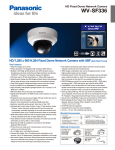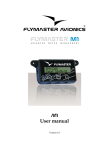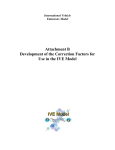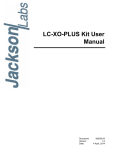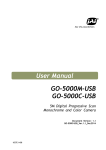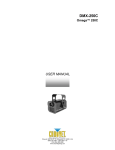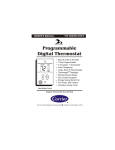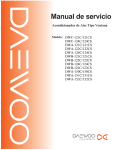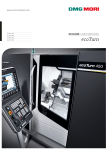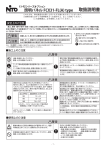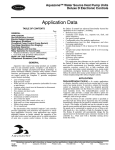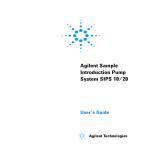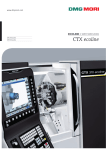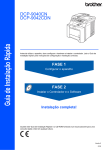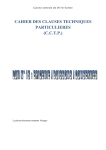Download HWA Water Chillers ONLY COOLING, HEAT PUMP AND FREE
Transcript
HWA Water Chillers Installation, use and maintenance manual ONLY COOLING, HEAT PUMP AND FREE-COOLING UNITS COMPANY WITH QUALITY SYSTEM CERTIFIED BY AFAQ-AFNOR =ISO 9001/2000= HWA INDEX TECHNICAL DATA Ref. technical data label PAGE 1 THE SERIES 4 2 FIELD OF APPLICATION 4 3 GENERALITIES 4 4 INSPECTION, CONVEYANCE, SITING 5 5 6 7 8 9 4.1 INSPECTION 5 4.2 LIFTING AND CONVEYANCE 5 4.3 UNPACKING 6 4.4 SITING 6 INSTALLATION 7 5.1 INSTALLATION CLEARANCE REQUIREMENTS 7 5.2 GENERAL GUIDELINES FOR PLUMBING CONNECTIONS 8 5.3 WATER CONNECTION TO THE EVAPORATOR 9 5.4 INSTRUCTIONS FOR THE FILLING UP OF THE TANK 10 5.5 SAFETY VALVE DRAIN PIPES 11 ELECTRICAL CONNECTIONS 11 6.1 GENERALITIES 11 6.2 ELECTRIC CONNECTIONS OF FLOW SWITCH OR DIFFERENTIAL WATER PRESSURE SWITCH 12 6.3 ELECTRIC CONNECTIONS OF THE CIRCULATION PUMP 12 6.4 REMOTE CONTROLS 12 6.5 REMOTE SUMMER-WINTER SWITCHING 12 STARTING UP 12 7.1 PRELIMINARY CHECKS 12 7.2 STARTING OPERATION 13 7.3 CHECKS DURING OPERATION 14 7.4 CHECKING THE REFRIGERANT LEVEL 14 7.5 STOPPING THE UNIT 15 OPERATING LIMITS 16 8.1 WATER FLOW TO EVAPORATOR 16 8.2 CHILLED WATER TEMPERATURES 16 8.3 OUTDOOR AIR TEMPERATURE 16 8.4 OPERATION WITH WATER AT LOW TEMPERATURES 16 8.5 FREE COOLING VERSION HWA-F 17 CONTROL DEVICE SETTINGS 9.1 GENERALITIES 9.2 MAXIMUM PRESSURE SWITCH File :HWAF-0-UM-GB-04_LENNOX.doc 21 21 23 Validità: 21 05 2007 2 HWA 9.3 MINIMUM PRESSURE SWITCH 23 9.4 SERVICE THERMOSTAT 23 9.5 ANTIFREEZE THERMOSTAT 23 9.6 ANTI-RECYCLE TIMER 23 9.7 OIL DIFFERENTIAL PRESSURE SWITCH 24 10 ROUTINE MAINTENANCE AND CHECKS 24 10.1 WARNINGS 24 10.2 GENERALITIES 25 10.3 REPAIRING THE COOLING CIRCUIT 25 10.4 TIGHTNESS TEST 25 10.5 HARD VACUUM AND DRYING OF THE COOLING CIRCUIT 26 10.6 CHARGING WITH R407C REFRIGERANT 26 10.7 ENVIRONMENTAL PROTECTION 27 11 RETIRING THE UNIT 27 12 TROUBLESHOOTING 27 13 WATER PRESSURE DROPS 31 13.1 EVAPORATOR PRESSURE DROPS 31 13.2 RECUPERATOR PRESSURE DROPS 31 13.3 FREE COOLING COILS PRESSURE DROPS 32 13.4 WEIGHTS SUMMARIZING TABLES 32 13.4.1 TOTAL WEIGHTS STD C-H-F 33 13.4.2 HYDRONIC MODULES WEIGHTS C-H 35 13.4.3 HYDRONIC MODULES WEIGHTS F 37 13.5 WATER PUMPING AND STORAGE SYSTEMS File :HWAF-0-UM-GB-04_LENNOX.doc Validità: 21 05 2007 39 3 HWA Declaration of conformity Hiref S.p.A., whose main office is at n°31/33 Viale Spagna, Tribano (Pd) - Italy, hereby declares, under its sole responsibility, that the HWA water chillers, CS-CL only cooling, HS-HL with heat pump and FS-FL with free-cooling, devices for air conditioning systems, conform to the specifications of EEC Directives 73/23, 89/392, 91/368, 93/44, 93/68, 97/23, 89/336. Tribano li, 05/04/2006 Luigi Galletti President 1 THE SERIES The group series includes: - Chillers with fluid and heat pump HWA CS-CL-HS-HL, which cover a power range from 44.8 to 304.9 kW - Chillers with liquid HWA FS-FL, which cover a power range from 46.2 to 301.2 kW 2 FIELD OF APPLICATION These machines are designed to cool-heat water and solutions containing up to 30% glycol (percentage by weight) in civil, industrial and technological air-conditioning systems. They must be used in observance of the operating limits specified in this manual; failure to comply with said limits will invalidate the warranties provided in the contract of sale. 3 GENERALITIES - When installing or servicing the chiller, you must strictly follow the rules provided in this manual, comply with the directions on the units and take all such precautions as are necessary. - The fluids under pressure in the cooling circuit and the presence of electrical components may cause hazardous situations during installation and maintenance work. Therefore, only qualified personnel may perform any kind of work on the unit. ONLY QUALIFIED PERSONNEL MAY EXECUTE THE FIRST START-UP OF THE UNIT AND IT IS NECESSARY THE AUTHORIZATION BY GALLETTI S.P.A. (SEE ATTACHMENT) - Failure to comply with the rules provided in this manual or any modification made to the unit without prior authorisation will result in the immediate invalidation of the warranty. Warning: Before performing any kind of work on the unit, make sure it has been disconnected from the power supply. File :HWAF-0-UM-GB-04_LENNOX.doc Validità: 21 05 2007 4 HWA 4 INSPECTION, CONVEYANCE, SITING 4.1 INSPECTION On receiving the unit, check that it is perfectly intact: the machine left the factory in perfect conditions; immediately report any signs of damage to the carrier and note them on the Delivery Slip before signing it. Galletti S.p.A. or its Agent must be promptly notified of the entity of the damage. The Customer must submit a written report describing every significant sign of damage. - Starting operation ratio, - Electric pattern, - Certificate of warrantee and list of assistance centres, - Check integrity of this user manual. 4.2 LIFTING AND CONVEYANCE While the unit is being unloaded and positioned, utmost care must be taken to avoid abrupt or violent manoeuvres. The unit must be handled carefully and gently: avoid using machine components as anchorages when lifting or moving it. The unit must be lifted using steel pipes of Ø1½” GAS with depth at least 3mm inserted through the eyebolts provided on the base frame (see fig. below) and check off with appropriate stickers. The pipes which must run at least 300mm out of each side should be harnessed with rope all equal and ensured to the uplift hook (firms at pipes ends are necessary to avoid that, because of the unit weight, the rope run away from the pipe itself). Use ropes or belts of adequate length (longer than the unit height) and spacer bars put on the unit top to avoid damaging the sides and top of the unit itself. Warning: In all lifting operations make sure that the unit is securely anchored in order to prevent accidental falls or overturning. File :HWAF-0-UM-GB-04_LENNOX.doc Validità: 21 05 2007 5 HWA 4.3 UNPACKING The packing must be carefully removed to avoid the risk of damaging the unit. Different packing materials are used: wood, cardboard, nylon etc. It is recommended to keep them separately and deliver them to suitable waste disposal or recycling facilities in order to minimise their environmental impact. Inside the unit, if provided with pump/s and/or tank, you’ll find the expansion pot packed, and you have to fix it on the suction pipes of the pump, in which you can find a “TEE” tight-fixed, or on the tank itself. Remove the top and screw down the expansion pot (only made by qualified personnel) before filling the circuit with water and starting up the unit. 4.4 SITING You should bear in mind the following aspects when choosing the best site for installing the unit and the relative connections: - size and origin of water pipes; - location of power supply; - accessibility for maintenance or repairs; - solidity of the supporting surface; - ventilation of the air-cooled condenser and necessary clearance; - direction of prevalent winds: avoid positioning the unit in such a way that the prevalent winds favour the backflow of air to the condenser coils; a speed of 8 m/s (28.8 km/h) already generates a sufficient stagnation pressure to guarantee 60% of the nominal air flow rate.[In situations where the action of air currents is inevitable and there is a simultaneous presence of temperatures below – 5°C, the control of condensation for low outdoor temperatures must be of the flooding type or with a device for choking the condensing exchanger -contact the technical department for further details] - possible reverberation of sound waves. All models belonging to the HWA series are designed and built for outdoor installation: avoid covering them with roof structures or positioning them near plants (even if they only partly cover the unit) which may interfere with the regular ventilation of the unit condenser. It is a good idea to create a base of adequate dimensions to support the unit. This precaution becomes essential when the unit is to be sited on unstable ground (various types of soil, gardens, etc.). It is advisable to place a rigid rubber strip between the base frame and the supporting surface. Whenever more effective insulation is required, it is recommended to use vibrating-damping spring supports. In the case of installation on roofs or intermediate storeys, the unit and pipes must be insulated from walls and ceilings by placing rigid rubber joints in between and using supports that are not rigidly anchored to the walls. If the unit is to be installed in proximity to private offices, bedrooms or areas where noise levels must be kept down, it is advisable to conduct a thorough analysis of the sound field generated and verify its compatibility with the local laws in force. File :HWAF-0-UM-GB-04_LENNOX.doc Validità: 21 05 2007 6 HWA 5 INSTALLATION 5.1 INSTALLATION CLEARANCE REQUIREMENTS It is of fundamental importance to ensure an adequate volume of air both on the intake and outlet sides of the condenser coils; it is highly important to prevent the air delivered from being re-aspirated as this may impair the performance of the unit or even cause an interruption in normal operation. For this reason it is necessary to guarantee the following clearances (see figure on this page): - rear side/plumbing connections: min. 1.5 metres to guarantee access to plumbing connections and/or for any necessary maintenance on the pumps, reservoir, expansion tank and flow switch. - electric control board side: min. 1.5 metres to guarantee access for inspection and/or maintenance of cooling components - coil side: min. 1.5 metres to ensure proper air circulation and access to the compressor compartment, also from the side. - top side: there must be no obstacle to expulsion. 1,5 m 1,5 m 1,5 m 1,5 m File :HWAF-0-UM-GB-04_LENNOX.doc Validità: 21 05 2007 7 HWA 5.2 GENERAL GUIDELINES FOR PLUMBING CONNECTIONS When you are getting ready to set up the water circuit for the evaporator you should follow the directions below and in any case make sure you comply with national or local regulations (use the diagrams included in this manual as your reference). - Connect the pipes to the chiller using flexible couplings to prevent the transmission of vibrations and to compensate thermal expansions. - It is recommended to install the following components on the pipes: • temperature and pressure indicators for routine maintenance and monitoring of the unit. Checking the pressure on the water side will enable you to verify whether the expansion tank is working efficiently and to promptly detect any water leaks within the equipment. • traps on incoming and outgoing pipes for temperature measurements, which can provide a direct reading of the operating temperatures. Temperature readings can in any case be obtained from the microprocessor installed on the unit. • regulating valves (gate valves) for isolating the unit from the water circuit. • metal mesh filter (incoming pipes), with a mesh not to exceed 1 mm, to protect the exchanger from scale or impurities present in the pipes. • air vent valves, to be placed at the highest points of the water circuit for the purpose of bleeding air. [The internal pipes of the unit are fitted with small air vent valves for bleeding the unit itself: this operation may only be carried out when the unit is disconnected from the power supply – mainly on Free-Cooling units be sure that the circuit is completely full of water, than clean the water coils from air to avoid cavitation events of the pump itself]. • drainage valve and, where necessary, a drainage tank for emptying out the equipment for maintenance purposes or when the unit is taken out of service at the end of the season. [A 1” drainage valve is provided on the optional water storage reservoir: this operation may only be carried out when the unit is disconnected from the power supply] • It is necessary to use glycolic solutions on FS-FL units (max. 30% of weight) to prevent hardly reparable damages at the finned coil caused by freezing of the coil itself. Check carefully the minimum air T which the unit could be espose to and consequently define the % of antifreeze to add. If you don’t use antifreeze solutions you may cause serious damages to the freecooling coils and in general to the hydraulic / cooling circuit. File :HWAF-0-UM-GB-04_LENNOX.doc Validità: 21 05 2007 8 HWA 5.3 WATER CONNECTION TO THE EVAPORATOR It is of fundamental importance that the incoming water supply is hooked up to the connection marked “Water Inlet” Otherwise the evaporator would be exposed to the risk of freezing since the antifreeze thermostat would not be able to perform its function; moreover the reverse cycle would not be respected in the cooling mode, resulting in additional risks of malfunctioning The dimensions and position of plumbing connections are shown in the dimension tables at the back of the manual. The water circuit must be set up in such a way as to guarantee that the nominal flow rate of the water supplied to the evaporator remains constant (+/- 15%) in all operating conditions. The compressors often work intermittently, since the chilling requirements of the user generally do not coincide with the compressor output. In systems containing little water, where the thermal inertia of the water itself is lower, it is a good idea to check that the water content in the section delivering to users satisfies the condition below: V = V Sh ρ Dτ DT Cc Ns Cc × ∆τ ρ × Sh × ∆Τ × Ns = water content in user section = specific heat of the fluid = fluid density = minimum time lapse between 2 compressor restarts = allowed water T differential = Cooling capacity = N° of choking steps [m3] [J/(kg/°C)] [kg/m3] [s] [°C] [W] Tank Ts Q; TW in File :HWAF-0-UM-GB-04_LENNOX.doc Q; TW out Validità: 21 05 2007 9 HWA A standard feature of HWA / HWA-F units is a device for controlling the flow rate (flow switch or differential pressure switch) in the water circuit in the immediate vicinity of the evaporator. Frame 3, 4, 5 units include a blade-type flow switch positioned in the ventilation compartment. Any tampering with said device will immediately invalidate the warranty. It is advisable to install a metal mesh filter on the inlet water pipe. It is strongly recommended to install a safety valve in the water circuit. In the event of serious equipment faults (e.g. fire) it will enable water to be drained from the system, thereby preventing possible bursts. Always connect the drain outlet to a pipe with a diameter at least as large as that of the valve opening and direct it toward an area where the discharge of water cannot harm people. This is a standard feature of units equipped with the optional storage reservoir. Warning: When making the plumbing connections, make sure there are no open flames in proximity to or inside the unit. 5.4 INSTRUCTIONS FOR THE FILLING UP OF THE TANK The tank is not planned to resist to a depression greater than -0,15 Bar, so pay attention to the fact that the suction pressure of the pump, where the expansion tank is positioned, has to be always greater than 0,5 Bar with the pump in operation: this fact also contributes to reduce any risks concerning the cavitation of the pump. It is of fundamental importance for the installer to follow and check the instructions written below stepwise, so as to avoid every kind of risks concerning the implosion of the tank or the cavitation of the pump: a) Empty the expansion tank until the pressure is 0,5 Bar b) Charge the system and pressurize it until about + 1 Bar in suction, pump side (with pump not working) c) Allow air to escape from the system d) Check the suction pressure of the pump (about 1 Bar) and start the system e) Stop the pump after 15-30 minutes and repeat from point c) until you don’t hear noises, caused by air still present in the system, anymore. File :HWAF-0-UM-GB-04_LENNOX.doc Validità: 21 05 2007 10 HWA 5.5 SAFETY VALVE DRAIN PIPES Safety valves are fitted in each refrigerant circuit: some regulations provide that the refrigerant drained from the valves be conveyed to the outside by means of a suitable pipe with a diameter at least matching that of the valve drainage outlet; the valve must not be made to bear the weight of the pipe. The valves positioned on the compressor outlet only discharge hot saturated gas; those on the liquid receivers, despite being positioned in the top part of the latter, may discharge saturated liquid and pose a greater hazard of burns due to the strong dehydrating effect caused by the sudden evaporation of refrigerant fluid in contact with bodies having a T > -41 °C. Warning: Always direct the drain pipe toward an area where the discharge cannot harm people. 6 ELECTRICAL CONNECTIONS 6.1 GENERALITIES Before carrying out any job on electrical parts, make sure the power supply is disconnected. Check that the mains electricity supply is compatible with the specifications (voltage, number of phases, frequency) shown on the unit rating plate. The connection to the power supply should be made with a three-pole + neutral cable and earthing wire. The size of the cable and line protections must conform to the specifications provided in the wiring diagram. The supply voltage may not undergo fluctuations exceeding ±5% and the unbalance between phases must always be below 2%. The above operating conditions must always be complied with: failure to ensure said conditions will result in the immediate invalidation of the warranty. The electrical connections must be made in accordance with the information shown in the wiring diagram provided with the unit and current regulations. An earth connection is required by law. The installer must connect the earthing wire using the earthing terminal situated on the electric control board (yellow and green wire). The power supply to the control circuit is shunted from the power line through an insulating transformer situated on the electric control board. The control circuit is protected by suitable fuses. File :HWAF-0-UM-GB-04_LENNOX.doc Validità: 21 05 2007 11 HWA 6.2 ELECTRIC CONNECTIONS OF FLOW SWITCH OR DIFFERENTIAL WATER PRESSURE SWITCH It is pre-wired in all HWA units. Units up to model 105 feature a differential pressure switch that detects pressure drops upstream and downstream from the evaporator (outgoing – returning water in the case of units equipped with a pump system) ; units from model 115 to model 300 have a blade-type flow switch installed in series with water circuit. 6.3 ELECTRIC CONNECTIONS OF THE CIRCULATION PUMP If selected on ordering, it/they is/are supplied pre-wired with all HWA units. The pump must be started before the chiller and stopped after the latter (minimum recommended delay: 60 seconds). If included as an option, this function is already performed by the electric control board on the unit. 6.4 REMOTE CONTROLS If you wish to include a remote control for switching the unit on and off, you must remove the bridge between the contacts indicated in the wiring diagram and connect the remote ON/OFF control to the terminals themselves [see annexed wiring diagram]. All remote controls work with a very low voltage (24 Vac) supplied by the insulating transformer on the electric control board. 6.5 REMOTE SUMMER-WINTER SWITCHING If you wish to include a remote control for switching the unit between the summer and winter operating modes, you must remove the bridge between the contacts indicated in the wiring diagram and connect the remote switching control to the terminals themselves [see annexed wiring diagram]. 7 STARTING UP 7.1 PRELIMINARY CHECKS - Check that all the valves in the cooling circuit are open (liquid line). - Check that the electrical connections have been made properly and that all the terminals are securely tightened. This check should also be included in a periodic six-month inspection. - Check that the voltage at the RST terminals is 400 V ± 5% and make sure the yellow indicator light of the phase sequence relay is on. The phase sequence relay is positioned in the middle right part of the electric control board; if the sequence is not duly observed, it will not enable the machine to start. - Make sure there are no refrigerant leaks that may have been caused by accidental impacts during transport and/or installation. - Check that the crankcase heating elements are properly connected to the power supply (present on HS-HL-FS-FL units, by series). File :HWAF-0-UM-GB-04_LENNOX.doc Validità: 21 05 2007 12 HWA The heating elements must be turned on at least 12 hours before the unit is started. Their function is to raise the T of the oil in the sump and limit the quantity of refrigerant dissolved in it. To verify whether the heating elements are working properly, check the lower part of the compressors: it should be warm or in any case at a temperature 10 - 15 °C higher than the ambient temperature. Pressure Oil T % R407C in oil The diagram above illustrates a specific property [Charles’ Law] of gases, which are more soluble in liquids as the pressure increases but less soluble as the temperature increases: if the oil in the sump is held at a constant pressure, an increase in temperature will significantly reduce the amount of refrigerant dissolved in it, thus ensuring that the lubricating function desired is maintained. - Check that the plumbing connections have been properly made according to the indications given on the plates to be found on the unit itself (proper inlet and outlet connections). - Make sure that the water circuit is duly bled to completely eliminate the presence of air: load the circuit gradually and open the air vent valves on the top part, which the installer should have set in place. 7.2 STARTING OPERATION Before starting the chiller, turn the main switch off, select the operating mode desired from the control panel [red button = heating, green button = cooling] and press the "ON" button on the control panel. The - unit will start up if enabled: by the safety devices of the water circulation pump/s by the flow switch (or differential pressure switch) by the T sensor measuring the temperature of the water returning from the system [chiller inlet] and no alarms have been triggered If the unit fails to start up, check whether the service thermostat has been set according to the nominal values provided You should not disconnect the unit from the power supply during periods when it is inoperative but only when it is to be taken out of service for a prolonged period (e.g. at the end of the season). To turn off the unit temporarily follow the directions provided in the section "Stopping the Unit" File :HWAF-0-UM-GB-04_LENNOX.doc Validità: 21 05 2007 13 HWA 7.3 CHECKS DURING OPERATION - Check the phase sequence relay on the electric panel to verify whether the phases occur in the correct sequence: if they do not, disconnect the unit from power supply and invert two phases of the incoming three-pole cable. Never attempt to modify internal electrical connections: any undue modifications will render the warranty null and void. All the three-phase devices on the unit, compressor, water pump and fans have a set direction of rotation and were harmonized in the factory. - Check that the temperature of the water entering the evaporator is close to the value set on the service thermostat. 7.4 CHECKING THE REFRIGERANT LEVEL - After a few hours of operation, check whether the liquid level indicator has a green crown: a yellow colour indicates the presence of humidity in the circuit. In such a case the circuit must be dehumidified by qualified personnel. - Large quantities of bubbles should not appear through the liquid level indicator. A constant passage of numerous bubbles may indicate that the refrigerant level is low and needs to be topped up. The presence of a few bubbles is however allowed, especially in the case of high-glide ternary mixtures such as HFC R407C - - A few minutes after the compressors have started up, check that the end-of-condensation temperature shown on the pressure gauge (refer to the pressure gauge scale for the refrigerant R407C, marked with the initials B.P. - Bubble Point) is about 19÷22 °C higher than the temperature of the air entering the condenser with the fans driven at top speed. Also check that the end-of-evaporation temperature shown on the pressure gauge (refer to the pressure gauge scale for the refrigerant R407C, marked with the initials D.P. - Dew Point) is about 5÷6 °C lower than the temperature of the water leaving the evaporator. - Make sure the overheating of the cooling fluid is limited to between 5 and 8 °C: to this end: 1) read the temperature indicated by a contact thermometer placed on the compressor intake pipe; 2) read the temperature indicated on the scale of a pressure gauge likewise connected to the intake side; refer to the pressure gauge scale for the refrigerant R407C, marked with the initials D.P. (Dew Point). The degree of overheating is given by the difference between the temperatures thus determined. - Make sure that the undercooling of the cooling fluid is limited to between 4 and 6°C: to this end: 1) read the temperature indicated by a contact thermometer placed on the condenser outlet pipe; 2) read the temperature indicated on the scale of a pressure gauge connected to the liquid inlet at the condenser outlet; refer to the pressure gauge scale for the refrigerant R407C, marked with the initials B.P. (Bubble Point). File :HWAF-0-UM-GB-04_LENNOX.doc Validità: 21 05 2007 14 HWA The degree of undercooling is given by the difference between the temperatures thus determined. Warning: all HWA units are charged with R407C: any top-ups must be made by specialised personnel using the same type of refrigerant, exclusively in the liquid phase. Warning: the refrigerant R407C requires “POE” polyolester oil of a type approved by the compressor manufacturer. For no reason should a mineral oil be introduced into the oil circuit. Real P compressor outlet Average T (T1+T2)/2 P T1 (start of condensation) DEW POINT T2 (end of condensation) BUBBLE POINT R407C Heat content h - 7.5 The difference between the Dew Point and Bubble Point is known as “GLIDE” and this is a characteristic property of refrigerant mixtures. If pure fluids are used, the phase change occurs at a constant T and thus the glide is equal to zero. STOPPING THE UNIT To stop the unit press the "OFF" unit on the front panel. Warning: do not stop the unit using the main switch: the latter device serves to disconnect the unit from the electricity supply when there is no passage of current, i.e. when the unit is already turned OFF. Moreover, if you completely disconnect the unit from the electricity supply, the crankcase heating elements will receive no power, thereby jeopardising the integrity of the compressor the next time the unit is started. File :HWAF-0-UM-GB-04_LENNOX.doc Validità: 21 05 2007 15 HWA 8 OPERATING LIMITS Operating limits of HWA chillers in relation to the outlet water temperature and outdoor air temperature: Temperature of water leaving evaporator [°C]: Outdoor air temperature [°C]: 8.1 Min. 5 (30) -10 Max. 12 (45) 45 WATER FLOW TO EVAPORATOR The nominal flow rate is based on a thermal differential of 5° C between inlet and outlet water, in relation to the cooling capacity provided at the nominal water (12/7 °C) and air (35°C) temperatures. The maximum allowed flow rate is associated with a thermal differential of 3 °C: higher flow rates, though admissible, cause pointless, high drops in pressure. The minimum allowed flow rate is associated with a thermal differential of 8 °C or a minimum pressure drop of 10 kPa: lower flow rates cause a reduction in heat exchange coefficients and excessively low evaporation temperatures, which may trigger the safety devices and cause the unit to stop. 8.2 CHILLED WATER TEMPERATURES The minimum temperature of the water leaving the evaporator is 5 °C: lower temperatures are possible, but for such applications the Manufacturer should be consulted at the time the order is placed. The maximum temperature of the water entering the evaporator is 20 °C. To allow higher temperatures specific equipment solutions must be adapted (split circuits, three-way valves, bypasses, storage reservoirs): contact the Manufacturer. 8.3 OUTDOOR AIR TEMPERATURE The units are designed and built to work with outdoor temperatures ranging from -10 (with condensation control) to 45 °C. Contact the Manufacturer in the event of outdoor temperatures beyond this range. On request, the units may be equipped with an electric heating element serving to heat the evaporator in cases where the unit is exposed to rigid temperatures during wintertime periods of quiescence. The heating element is activated whenever the temperature of the water leaving the evaporator falls below the temperature set on the antifreeze heating element. 8.4 OPERATION WITH WATER AT LOW TEMPERATURES The standard units are not designed to work with chilled water temperatures below 5 °C at the evaporator outlet. In order to work below this limit, the unit requires specific technical adjustments: in such cases contact the Manufacturer. File :HWAF-0-UM-GB-04_LENNOX.doc Validità: 21 05 2007 16 HWA 8.5 FREE COOLING VERSION HWA-F Free Cooling units are only in cooling execution and it’s not possible to link this execution with the heat pump one. The series of these units, because of the particular application type, is equipped with a condensation pressure control device and microprocessor ADVANCED control. The following picture shows the normal field of application of free cooling units. Produced water T (*) 13° 10° Outdoor air temp. T 5° -18° 42° 44° The inferior limit is dew to the freezing temperature limitation of glycolated solutions of 35% of glycol weight, that is the maximum value possible for the tightness of the pumps in use. On demand, special ceramic tights of the pumps are available to allow the employment with T lower than the listed ones (use of glycol in % up to 50 % of weight). Produced water min. temperature °C Etilenic glicol weight steel % Blend freezing temperature 5 2 -1 -5 -10 0% 10 % 15% 25 % 30 % 0 -4 -8 -14 -18 The series of free cooling units is provided with the heaters of the compressor oil sump. The picture below fig. "Oil" shows the characteristic [Charles’ law] for gases that melt in a liquid in greater volumes as well as the pressure and the contemporary temperature opposition action are higher: on equal pressure in the sump, an oil temperature increase reduces the melt refrigerant volume sensibly so that you could obtain the maintenance of the desired lubrication characteristics. The problem of insufficient lubrication, when a suitable heating of the carter is absent, occurs mainly after stops during which, because of the lift compressor, there occurs a sudden pressure droop in the sump and consequently a strong evaporation of the refrigerant melt before in the oil. This event, when there are no heatings, could cause 2 problems: oil dilution than insufficient lubrication oil migration towards the cooling circuit because of the dragging of the refrigerant. File :HWAF-0-UM-GB-04_LENNOX.doc Validità: 21 05 2007 17 HWA fig. “oil” Pressure T olio % R407C in oil Using the heaters is important mainly during the first starting up of the unit, and it is better to switch them on at least 12 hours before starting the compressors up. If outdoor air T decreases a lot, the system water T control is warranted by the modulating action of the fans and, in the negative (strong dominant winds), by the 3-way valve lock. Only on demand, for borderline cases, the modulating joint action by the 3-way valve is available. Cooling circuit in Free Cooling units In addition to above-written, Free Cooling units are provided with a 3-way valve able to deviate the flow towards the Free Cooling coils, that are put upstream, compared with the condensing ones, in the air flow. The valve activation is controlled by microprocessor (ADVANCED on series) that check the difference between the set-point T of water coming back from the user (T1) and outdoor air (T2). [fig. 5] fig. 5 T2 Free cooling coil/s Back from users T3 T1 The probe put at the evaporator input (T3) than pilots the compressors starting up in integration in the event that the free cooling performance is not sufficient to cover the whole thermal requirements. The temperatures T1 and T3 are always controlled by the microprocessor on board to verify possible anomalies of the free cooling 3-way valve: for example, if you have free cooling phase, so with exchanged valve, but T1 and T3 are equal, it means that the valve is blocked; in case of free cooling anomalies, you can decide to produce only an alarm or to force the unit in power off. File :HWAF-0-UM-GB-04_LENNOX.doc Validità: 21 05 2007 18 HWA The 3-way valve is also predisposed to manual positioning if there are some anomalies in the service servo-motor: in the following picture you can see the positioning of the 3-way valve 3-way valve in Free Cooling unit which you can have access to removing the cap shown in the following picture, for manual activation. Remove the cap to have access to the valve motor File :HWAF-0-UM-GB-04_LENNOX.doc Validità: 21 05 2007 19 HWA The free cooling execution allows a very great energy saving in all those situations in which the outdoor temperature is lower than the temperature of the circulating flow (process industry, close control applications, information technology in general, convention halls, etc.). The free cooling circuit performance depends on the difference between the outdoor air T and the circulating water T, as shown in the picture fig. 6 Fig. 6 Cooling capacity Free Cooling capacity Free Cooling only Cooler capacity Cooler nominal capacity Contemporary functioning Back water T Outdoor air T FFT Full Free Cooling Temperature when the outdoor air T2 decrease below the water T1 back from the user, it is possible to have thermal exchange and so free cooling action starts with a possible integration of one or more steps mechanical cooling. During this phase it is important to have the maximum air flow so that the free cooling coils capacity is maximized, and so as to have at the same time an effective control of the condensing pressure, the condensing coils are provided with a special partialization circuit that reduces their thermal exchange surfaces allowing in this way the unit to work with maximum air flow (fig.7) fig. 7 Section 1 Section 2 The both coil sections in fact are normally operating in only mechanical cooling working, but when Free Cooling phase is activated, so that outdoor air T2 are lower than (T1-Delta T)°C, in case of a contemporary mechanical cooling request (integration), the section 1 is excluded and the ventilation can be forced at most maintaining an excellent control of the condensing pressure. In total free cooling field, the cooling capacity is modulated regulating the fans speed to keep the outlet water T constant. To prevent that the 3-way valve blocks off, it is automatically exchanged up to 30% in every 140 h of work maintaining the cooler in motion. File :HWAF-0-UM-GB-04_LENNOX.doc Validità: 21 05 2007 20 HWA 9 CONTROL DEVICE SETTINGS 9.1 GENERALITIES All the control devices are set and tested in the factory before the unit is dispatched. However, after the unit has been in service for a reasonable period of time you can perform a check on the operating and safety devices. The settings are shown in Tables II and III. The control devices may be serviced SOLELY BY QUALIFIED TECHNICIANS: incorrect settings may cause serious damage to the unit and injury to persons. Many of the operating parameters and system settings are configured by means of the microprocessor control and are protected by passwords. TABLE II – SETTING OF CONTROL DEVICES - HWA SERIES CONTROL DEVICE Service Thermostat [CS-CL] Service Thermostat [HS-HL] °C °C SET POINT DIFFERENTIAL 12 40 4 4 SET POINT DIFFERENTIAL 10-18 1-3 - HWA-F SERIES CONTROL DEVICE Service Thermostat [FS-FL] °C File :HWAF-0-UM-GB-04_LENNOX.doc Validità: 21 05 2007 21 HWA TABLE III – SETTING OF SAFETY-CONTROL DEVICES - HWA SERIES CONTROL DEVICE Antifreeze thermostat Safety maximum pressure switch High pressure relief valve Minimum pressure switch Modulating condensation control device Time lapse between two starts of the same compressor Delay in flow switch alarm Delay in low pressure alarm Pump rotation [optional] End-of-defrost pressure Maximum defrost time Minimum time lapse between two defrosting operations ACTIVATION DIFFERENTIAL RESETTING °C bars bars bars bars s +4 28 29 2 14 480 2 4 1.5 7 - Automatic Manual Automatic s s h bars s s 20 120 24 19 360 1800 - - - - ACTIVATION DIFFERENTIAL RESETTING °C bars bars bars bars s +4 28 29 2 14 480 2 4 1.5 7 - Automatic Manual Automatic s s h bars s s 20 120 24 n.a. n.a. n.a. - - - - bars bars bars bars 3 3 6 16 - - HWA FREE-COOLING SERIES CONTROL DEVICE Antifreeze thermostat Safety maximum pressure switch High pressure relief valve Minimum pressure switch Modulating condensation control device Time lapse between two starts of the same compressor Delay in flow switch alarm Delay in low pressure alarm Pump rotation [optional] End-of-defrost pressure Maximum defrost time Minimum time lapse between two defrosting operations Safety valve water side Max PN water side with tank Max PN standard 3-way valve Max PN 3-way valve stem (option) File :HWAF-0-UM-GB-04_LENNOX.doc Validità: 21 05 2007 - 22 HWA 9.2 MAXIMUM PRESSURE SWITCH The high pressure switch is of the manually reset type and classifiable as category IV under EEC 97/23. It directly stops the compressor when the discharge pressure exceeds the set value. Warning: do not attempt to change the setting of the pressure switch: should the latter fail to trip in the event of a pressure increase, the pressure relief valve will open! To verify its efficiency, while the compressors are running, close off the passage of air into the condensers and check by referring to the compressor outlet pressure gauge (previously installed) whether the pressure switch trips (i.e. the compressors stop) when the set value is reached. Warning: while you are carrying out this check, you should be ready to shut off the unit as directed in the section "Stopping the Unit" in case the safety device fails to trip The high pressure switch must be manually rest; this is possible only when the pressure falls below the set differential (see Table III). 9.3 MINIMUM PRESSURE SWITCH The low pressure switch stops the compressor when the intake pressure falls below the set value for more than 180 seconds. The switch is automatically reset when the pressure rises above the set differential (see Table III); however, the unit will not resume operation until the alarm memory on the microprocessor control is cleared. 9.4 SERVICE THERMOSTAT The function of this device is to start and stop the compressors according to the demand for chilled water, as determined by a sensor placed at the evaporator inlet [water returning from the circuit] This device is a function included in the microprocessor control and works with a proportional bandwidth that may be set as desired. 9.5 ANTIFREEZE THERMOSTAT The antifreeze sensor situated at the evaporator outlet detects the presence of excessively low temperatures and stops the unit. Together with the flow switch and low pressure switch, this device protects the evaporator from the risk of freezing as a result of faults in the water circuit. This device is a function included in the microprocessor control. 9.6 ANTI-RECYCLE TIMER The function of the timer is to prevent excessively frequent compressor starts and stops. This device is a function included in the microprocessor control. It imposes a minimum time lapse of 300 seconds between two successive starts. Never attempt to change the delay set in the factory: wrong settings could cause serious damage to the unit. File :HWAF-0-UM-GB-04_LENNOX.doc Validità: 21 05 2007 23 HWA 9.7 OIL DIFFERENTIAL PRESSURE SWITCH HWA units are equipped with spinning scroll compressors; these compressors do not have a lubricant pump and therefore no oil differential pressure switch is provided. 10 ROUTINE MAINTENANCE AND CHECKS 10.1 WARNINGS All the operations described in this chapter MUST ALWAYS BE PERFORMED BY QUALIFIED PERSONNEL. Before carrying out any work on the unit or accessing internal parts, make sure you have disconnected it from the mains electricity supply. The upper part and outlet pipe of the compressor may reach temperatures as high as 110°C. Be especially careful when working in the surrounding area while the unit is running. Be especially careful when working in proximity to finned coils since the 0.11 mm-thick aluminium fins can cause superficial injuries due to cuts. After completing maintenance jobs, always replace the panels enclosing the units and secure them with the fastening screws provided. File :HWAF-0-UM-GB-04_LENNOX.doc Validità: 21 05 2007 24 HWA 10.2 GENERALITIES It is a good idea to carry out periodic checks to ensure that the unit is working properly: • Check the efficiency of all the control and safety devices as previously described. • Check the terminals on the electric control board and compressor terminal boards to ensure that they are securely tightened. The movable and fixed contacts of the circuit breakers must be periodically cleaned and replaced whenever they show signs of deterioration. • Check the refrigerant level by means of the liquid level indicator (every 6 months). • Check the oil levels through the windows provided on the compressor crankcases (every 6 months). • Check the water circuit for leaks (every 6 months). • If the unit has to remain out of service for a long time, drain the water from the pipes and heat exchanger, from the pump/s (option), from the collect tank (option), and from the water coil if they are FREE COOLING units (if you don’t use glycolated solutions). This is indispensable if during the period of quiescence the ambient temperature is expected to fall below the freezing point of the fluid used (routine seasonal operation). • Check the replenishment of the hydraulic circuit allowing air in the circuit to escape from the small valves put on the highest points. • Check the efficiency of the flow switch or differential pressure switch • Check the heating elements, where present, of the compressor crankcases. • Clean the metal mesh filters mounted externally on the water pipes. • Check the humidity indicator on the liquid level indicator (green=dry, yellow=humid); if the indicator is not green as shown on the indicator sticker, replace the filter (every 6 months). • Check that the noise emissions of the unit are regular (every 6 months) and more specifically that no vibrations and/or knocking can be detected. 10.3 REPAIRING THE COOLING CIRCUIT Warning: while performing repairs on the cooling circuit or maintenance work on the compressors, make sure the circuit is left open for as little time as possible. Even if briefly exposed to air, ester oils tend to absorb large amounts of humidity, which results in the formation of weak acids. If the cooling circuit has undergone any repairs, the following operations must be carried out: - tightness test; - emptying and drying of the cooling circuit; - charging with refrigerant. If the system has to be drained, always recover the refrigerant present in the circuit using suitable equipment; the refrigerant should be handled exclusively in the liquid phase. 10.4 TIGHTNESS TEST Fill the circuit with anhydrous nitrogen supplied from a tank with a pressure-reducing valve until the pressure rises to 10 bars. During the pressurisation phase, do not exceed the pressure setting of the safety valves; otherwise you will cause the latter to open. File :HWAF-0-UM-GB-04_LENNOX.doc Validità: 21 05 2007 25 HWA The presence of any leaks must be determined using special leak detectors. Should any leaks be detected during the test, empty out the circuit before repairing the leaks with suitable alloys. Do not use oxygen in the place of nitrogen as a test agent, since this could cause a risk of explosion as well as the certainty of extensive oxidisation in high-temperature areas. 10.5 HARD VACUUM AND DRYING OF THE COOLING CIRCUIT To achieve a hard vacuum in the cooling circuit it is necessary to use a pump capable of generating a high degree of vacuum, i.e. 15 Pa of absolute pressure. If there is no suitable vacuum pump available, or whenever the circuit has remained open for long periods of time, you are strongly recommended to adopt the triple evacuation method. This method is also recommended when there is a presence of humidity within the circuit. The vacuum pump should be connected to the inlets. The procedure to be carried out is as follows: - Evacuate the circuit until you reach an absolute pressure of at least 35 Pa: at this point inject nitrogen into the circuit until you reach a relative pressure of about 1 bar. - Repeat the step described above. - Carry out the step described above for the third time, but in this case attempting to reach the hardest vacuum possible. Using this procedure you can easily remove up to 99% of pollutants. 10.6 CHARGING WITH R407C REFRIGERANT - Connect the cylinder of refrigerant gas to the male 1/4 SAE inlet situated on the liquid line after discharging a little gas to eliminate air in the connection pipe. - Carry out the charging operation with the refrigerant in liquid form until you reach 75% of the total charge. -Then connect to the inlet on the intake line and complete the charging process with the refrigerant in liquid form until no more bubbles can be seen on the liquid level indicator and the operating parameters specified in the section "Checking the refrigerant level" have been reached”. Since R407C is a ternary mixture, charging must take place exclusively with liquid refrigerant to ensure the correct percentages of the three constituents. Introduce refrigerant through the inlet in the liquid line. A unit that was originally charged with R407C in the factory cannot be charged with R22 or other refrigerants. File :HWAF-0-UM-GB-04_LENNOX.doc Validità: 21 05 2007 26 HWA 10.7 ENVIRONMENTAL PROTECTION The law implementing the regulations [reg. EEC 2037/00] which govern the use of ozone-depleting substances and greenhouse gases bans the dispersal of refrigerant gases in the environment and requires whoever is in their possession to recover them and, at the end of their useful life, either to return them to the dealer or take them to a suitable waste disposal facility. The refrigerant HFC R407C is not harmful to the ozone layer but is included among the substances responsible for the greenhouse effect and thus falls within the scope of the aforesaid regulations. Therefore, special care should be taken when carrying out maintenance work to minimise refrigerant leaks. 11 RETIRING THE UNIT When the unit has reached the end of its working life and needs to removed and replaced, a series of operations should be carried out: - the refrigerant gas it contains should be recovered by specialised personnel and sent to a waste collection facility; - the lubricating oil in the compressors should also be recovered and sent to a waste collection facility; - if they cannot be reused, the framework and components should be scrapped and separated according to the type of material: this applies especially for the considerable quantities of copper and aluminium present in the unit. This will make the job of waste collection, disposal and recycling facilities easier and minimise the environmental impact of such processes. 12 TROUBLESHOOTING On the next pages you will find a list of the most common causes that may cause the chilling unit to fail or malfunction. These causes are broken down according to easily identifiable symptoms. You should be extremely careful when attempting to implement any of the possible remedies suggested: overconfidence can result in injuries, even serious ones, to inexpert individuals. Therefore, once the cause has been identified, you are advised to contact the manufacturer or a qualified technician for help. File :HWAF-0-UM-GB-04_LENNOX.doc Validità: 21 05 2007 27 HWA FAULT The unit does not start Possible causes No power supply Corrective actions Check that power is being supplied both to the primary and auxiliary circuits. The electronic card is cut off from Check the fuses the power supply Alarms have been triggered Check whether any alarms are signalled on the microprocessor control panel, eliminate the causes and restart the unit. The phase sequence is wrong Invert two phases in the primary power line after disconnecting them upstream from the unit The compressor is noisy The compressor is rotating in the Check the phase sequence relay. wrong direction Invert the phases on the terminal board after disconnecting the unit and contact the manufacturer. Presence of abnormally high Insufficient flow of air to the Check whether all the fans are pressure condenser turning properly Check the air T at the condenser inlet and make sure no back suction occurs Check whether the effective RMS voltage to the fans is the maximum. If necessary, check the pressure transducers controlling the revolution regulator, where present [optional] Check the cleanliness of the finned coils Presence of air in the refrigerant circuit, as revealed by the presence of bubbles in the flow indicator also with undercooling values exceeding 5 °C Drain and pressurise the circuit and check for leaks. Generate a slow vacuum [longer than 3 hours] until reaching a pressure of 15 Pa and then recharge in the liquid phase Unit overcharged, as revealed by Drain the circuit an undercooling of more than 8 °C Thermostatic valve and/or filter Check the temperatures upstream obstructed. These symptoms may and downstream from the valve also occur in the presence of an and filter and replace them if abnormally low pressure. necessary. Insufficient flow of water in the Check the water circuit for case of heat pump operation pressure drops and/or whether the pump is working properly [direction of rotation]. Check the outgoing water T and make sure it less than or equal to 45°C File :HWAF-0-UM-GB-04_LENNOX.doc Validità: 21 05 2007 28 HWA FAULT Possible causes Low condensation pressure Transducer fault Low evaporation pressure Insufficient flow of water Corrective actions Check the transducers and the efficiency of the needle pusher on the schrader valves they are connected to Outdoor T too low and/or presence Install the condensation control of strong winds device and/or protect the unit from prevalent winds Low water T, in the case of heat Check whether the thermal load is pump operation compatible with the unit’s potential. Malfunctioning valve Check whether the pumps are rotating in the right direction. Check the water system for pressure drops. Check the efficiency of the pump system check valve (optional) thermostatic Warming the bulb with your hand, check whether the valve opens and adjust it if necessary. If it does not respond, replace it. Filter clogged Pressure drops upstream and downstream from the filter should not exceed 2°C. If they do, replace the filter. Low condensation T Check the efficiency of the condensation control device [where present] Low level of refrigerant Check the refrigerant level by measuring the degree of undercooling; if it is below 2°C replenish the charge Coil covered with frost, in the case Check whether the defrost of heat pump operation parameters have been properly set. Check the efficiency of the 4-way valve. Low outdoor T, if the unit is Check compliance with the operating with the heat pump on operating limits and eliminate any bypasses and back flow of air. The compressor does not start of The internal thermal protection device has tripped The circuit breakers or line fuses have been tripped by a short circuit One of the high or low pressure switches has tripped The phases have been inverted in the distribution compartment File :HWAF-0-UM-GB-04_LENNOX.doc Validità: 21 05 2007 In the case of compressors equipped with a protection module, check the thermal contact. Identify the causes after restarting. Pinpoint the cause by measuring the resistance of the individual windings and the insulation from the casing before restoring power. Check on the microprocessor, eliminate the causes. Check the phase sequence relay. 29 HWA FAULT High evaporation pressure Possible causes Water T too high Corrective actions Check the thermal load and/or efficiency of the thermostat function. Check the efficiency of the thermostatic valve Defrosting absent or incomplete Error in parameter settings (HS-HL versions) Free Cooling malfunctioning (FS-FL units) File :HWAF-0-UM-GB-04_LENNOX.doc Check the setting of the start and end defrost parameters on the microprocessor Check whether defrosting water is properly drained from the coils Check the uniformity of the refrigerant circuit outlet temperatures at the top and bottom of the coils: the maximum thermal differential allowed is 10 °C. Check the refrigerant level The 4-way valve has failed to work Check whether it is regularly energized and deenergized. Failure to exchange the 3-way It is possible to hand-force the valve valve in activation to open, but it is advisable to leave the unit working only mechanically Failure to exchange the 3-way It is necessary to hand-force the valve in deactivation valve to close, replacing its servomotor as soon as possible. Validità: 21 05 2007 30 HWA 13 WATER PRESSURE DROPS 13.1 EVAPORATOR PRESSURE DROPS The diagram shows the pressure drops on the water side (Dpw) as a function of the water flow rate (Qw), assuming an average water temperature of 10°C 13.2 RECUPERATOR PRESSURE DROPS The diagram shows the pressure drops on the water side (Dpw) as a function of the water flow rate (Qw), assuming an average water temperature of 42.5°C File :HWAF-0-UM-GB-04_LENNOX.doc Validità: 21 05 2007 31 HWA 13.3 FREE COOLING COILS PRESSURE DROPS The diagram shows the pressure drops of the free cooling coils dependent on water flow, referred to the water average temperature 12 °C (outlet from the co ils). 13.4 WEIGHTS SUMMARIZING TABLES h In this draw you can see the points of the unit we have calculated the weight values for, and they are shown in the following tables: nota bene, the hydronic modules weight values (C-H, F; with 2 pumps+full tank, with 2 pumps, with 1 pump) must be added to the weight values of the standard units, basic version (C-H-F; only cooling STD, heat pump STD, free cooling STD). FRAME 1 2 3 4 5 6 File :HWAF-0-UM-GB-04_LENNOX.doc Validità: 21 05 2007 LENGHT 1960 2360 3140 3481.5 4296 4296 DEPTH 1197 1197 1197 1654 1654 1654 32 HEIGHT 1578.5 1578.5 1578.5 1637 1637 2137 HWA 13.4.1 TOTAL WEIGHTS STD C-H-F Only cooling HWA weights MODEL 045 050 FRAME 1 1 Total [kg] 581,15 591,99 L1 174,345 177,597 L2 174,345 177,597 L3 116,23 118,398 L4 116,23 118,398 L5 L6 L7 L8 MODEL 130CS 130CL FRAME 4 4 Total [kg] 1241,68 1272,68 L1 186,252 190,902 L2 186,252 190,902 L3 124,168 127,268 L4 124,168 127,268 L5 186,252 190,902 L6 186,252 190,902 L7 124,168 127,268 L8 124,168 127,268 MODEL 220CL 235CS FRAME 5 5 Total [kg] 1987,04 1931,04 L1 298,056 289,656 L2 298,056 289,656 L3 198,704 193,104 L4 198,704 193,104 L5 298,056 289,656 L6 298,056 289,656 L7 198,704 193,104 L8 198,704 193,104 Heat pump HWA weights MODEL 045 050 FRAME 1 1 Total [kg] 601,15 611,99 L1 180,345 183,597 L2 180,345 183,597 L3 120,23 122,398 L4 120,23 122,398 L5 L6 L7 L8 MODEL 130HS 130HL FRAME 4 4 Total [kg] 1271,68 1302,68 L1 190,752 195,402 L2 190,752 195,402 L3 127,168 130,268 L4 127,168 130,268 L5 190,752 195,402 L6 190,752 195,402 L7 127,168 130,268 L8 127,168 130,268 MODEL 220HL 235HS FRAME 5 5 Total [kg] 2024,04 1966,04 L1 303,606 294,906 L2 303,606 294,906 L3 202,404 196,604 L4 202,404 196,604 L5 303,606 294,906 L6 303,606 294,906 L7 202,404 196,604 L8 202,404 196,604 File :HWAF-0-UM-GB-04_LENNOX.doc 060 2 688,92 120,561 120,561 103,338 103,338 120,561 120,561 070 2 704,09 123,21575 123,21575 105,6135 105,6135 123,21575 123,21575 080 2 725,78 127,0115 127,0115 108,867 108,867 127,0115 127,0115 090 3 928,36 162,463 162,463 139,254 139,254 162,463 162,463 105 3 985,36 172,438 172,438 147,804 147,804 172,438 172,438 150CS 4 1426,37 213,9555 213,9555 142,637 142,637 213,9555 213,9555 142,637 142,637 235CL 5 1998,04 299,706 299,706 199,804 199,804 299,706 299,706 199,804 199,804 150CL 4 1472,37 220,8555 220,8555 147,237 147,237 220,8555 220,8555 147,237 147,237 250CS 6 2198,34 329,751 329,751 219,834 219,834 329,751 329,751 219,834 219,834 180CS 4 1585,31 237,7965 237,7965 158,531 158,531 237,7965 237,7965 158,531 158,531 250CL 6 2244,76 336,714 336,714 224,476 224,476 336,714 336,714 224,476 224,476 180CL 5 1830,54 274,581 274,581 183,054 183,054 274,581 274,581 183,054 183,054 280CS 6 2237,14 335,571 335,571 223,714 223,714 335,571 335,571 223,714 223,714 205CS 5 1885,54 282,831 282,831 188,554 188,554 282,831 282,831 188,554 188,554 280CL 6 2283,56 342,534 342,534 228,356 228,356 342,534 342,534 228,356 228,356 060 2 710,92 124,411 124,411 106,638 106,638 124,411 124,411 070 2 726,09 127,06575 127,06575 108,9135 108,9135 127,06575 127,06575 080 2 747,78 130,8615 130,8615 112,167 112,167 130,8615 130,8615 090 3 953,36 166,838 166,838 143,004 143,004 166,838 166,838 105 3 1010,36 176,813 176,813 151,554 151,554 176,813 176,813 150HS 4 1456,37 218,4555 218,4555 145,637 145,637 218,4555 218,4555 145,637 145,637 235HL 5 2034,04 305,106 305,106 203,404 203,404 305,106 305,106 203,404 203,404 150HL 4 1502,37 225,3555 225,3555 150,237 150,237 225,3555 225,3555 150,237 150,237 250HS 6 2261,86 339,279 339,279 226,186 226,186 339,279 339,279 226,186 226,186 180HS 4 1615,31 242,2965 242,2965 161,531 161,531 242,2965 242,2965 161,531 161,531 250HL 6 2308,28 346,242 346,242 230,828 230,828 346,242 346,242 230,828 230,828 180HL 5 1865,54 279,831 279,831 186,554 186,554 279,831 279,831 186,554 186,554 280HS 6 2330,66 349,599 349,599 233,066 233,066 349,599 349,599 233,066 233,066 205HS 5 1920,54 288,081 288,081 192,054 192,054 288,081 288,081 192,054 192,054 280HL 6 2347,08 352,062 352,062 234,708 234,708 352,062 352,062 234,708 234,708 Validità: 21 05 2007 33 115CS 4 1233,68 185,052 185,052 123,368 123,368 185,052 185,052 123,368 123,368 205CL 5 1885,54 282,831 282,831 188,554 188,554 282,831 282,831 188,554 188,554 300CS 6 2289,34 343,401 343,401 228,934 228,934 343,401 343,401 228,934 228,934 115CL 4 1264,68 189,702 189,702 126,468 126,468 189,702 189,702 126,468 126,468 220CS 5 1921,04 288,156 288,156 192,104 192,104 288,156 288,156 192,104 192,104 300CL 6 2305,76 345,864 345,864 230,576 230,576 345,864 345,864 230,576 230,576 115HS 4 1263,68 189,552 189,552 126,368 126,368 189,552 189,552 126,368 126,368 205HL 5 1920,54 288,081 288,081 192,054 192,054 288,081 288,081 192,054 192,054 300HS 6 2352,86 352,929 352,929 235,286 235,286 352,929 352,929 235,286 235,286 115HL 4 1294,68 194,202 194,202 129,468 129,468 194,202 194,202 129,468 129,468 220HS 5 1956,04 293,406 293,406 195,604 195,604 293,406 293,406 195,604 195,604 300HL 6 2369,28 355,392 355,392 236,928 236,928 355,392 355,392 236,928 236,928 HWA Free cooling HWA weights MODEL 045FS 045FL FRAME 1 2 Total [kg] 707,35 808,18 L1 212,205 141,4315 L2 212,205 141,4315 L3 141,47 121,227 L4 141,47 121,227 L5 141,4315 L6 141,4315 L7 L8 MODEL 080FS 080FL FRAME 2 3 Total [kg] 874,38 1056,76 L1 153,0165 184,933 L2 153,0165 184,933 L3 131,157 158,514 L4 131,157 158,514 L5 153,0165 184,933 L6 153,0165 184,933 L7 L8 MODEL 130FS 130FL FRAME 4 4 Total [kg] 1460,08 1491,08 L1 219,012 223,662 L2 219,012 223,662 L3 146,008 149,108 L4 146,008 149,108 L5 219,012 223,662 L6 219,012 223,662 L7 146,008 149,108 L8 146,008 149,108 MODEL 220FS 220FL FRAME 5 6 Total [kg] 2191,34 2560,76 L1 328,701 384,114 L2 328,701 384,114 L3 219,134 256,076 L4 219,134 256,076 L5 328,701 384,114 L6 328,701 384,114 L7 219,134 256,076 L8 219,134 256,076 File :HWAF-0-UM-GB-04_LENNOX.doc 050FS 1 718,19 215,457 215,457 143,638 143,638 050FL 2 819,02 143,3285 143,3285 122,853 122,853 143,3285 143,3285 060FS 2 837,52 146,566 146,566 125,628 125,628 146,566 146,566 060FL 2 858,52 150,241 150,241 128,778 128,778 150,241 150,241 070FS 2 852,69 149,22075 149,22075 127,9035 127,9035 149,22075 149,22075 070FL 2 873,69 152,89575 152,89575 131,0535 131,0535 152,89575 152,89575 090FS 3 1131,76 198,058 198,058 169,764 169,764 198,058 198,058 090FL 4 1460,28 219,042 219,042 146,028 146,028 219,042 219,042 146,028 146,028 150FL 5 1939,9 290,985 290,985 193,99 193,99 290,985 290,985 193,99 193,99 235FL 6 2572,16 385,824 385,824 257,216 257,216 385,824 385,824 257,216 257,216 105FS 3 1188,76 208,033 208,033 178,314 178,314 208,033 208,033 0105FL 4 1471,68 220,752 220,752 147,168 147,168 220,752 220,752 147,168 147,168 180FL 5 2100,84 315,126 315,126 210,084 210,084 315,126 315,126 210,084 210,084 250FL 6 2583,56 387,534 387,534 258,356 258,356 387,534 387,534 258,356 258,356 115FS 4 1452,08 217,812 217,812 145,208 145,208 217,812 217,812 145,208 145,208 205FS 5 2155,84 323,376 323,376 215,584 215,584 323,376 323,376 215,584 215,584 280FS 6 2575,94 386,391 386,391 257,594 257,594 386,391 386,391 257,594 257,594 115FL 4 1483,08 222,462 222,462 148,308 148,308 222,462 222,462 148,308 148,308 205FL 5 2209,84 331,476 331,476 220,984 220,984 331,476 331,476 220,984 220,984 300FS 6 2628,14 394,221 394,221 262,814 262,814 394,221 394,221 262,814 262,814 150FS 4 1644,77 246,7155 246,7155 164,477 164,477 246,7155 246,7155 164,477 164,477 235FS 5 2201,34 330,201 330,201 220,134 220,134 330,201 330,201 220,134 220,134 Validità: 21 05 2007 180FS 5 2052,84 307,926 307,926 205,284 205,284 307,926 307,926 205,284 205,284 250FS 6 2537,14 380,571 380,571 253,714 253,714 380,571 380,571 253,714 253,714 34 HWA 13.4.2 HYDRONIC MODULES WEIGHTS C-H Weights with 2 pumps + full tank (to be added to STD weight) MODEL 045 050 060 070 080 FRAME 1 1 2 2 2 Total [kg] 415,59 415,59 571,42 571,42 571,42 L1 83,118 83,118 57,142 57,142 57,142 L2 83,118 83,118 57,142 57,142 57,142 L3 124,677 124,677 114,284 114,284 114,284 L4 124,677 124,677 114,284 114,284 114,284 L5 114,284 114,284 114,284 L6 114,284 114,284 114,284 L7 L8 MODEL 130CS-HS 130CL-HL 150CS-HS 150CL-HL 180CS-HS FRAME 4 4 4 4 4 Total [kg] 895,6 895,6 896,6 896,6 934,6 L1 17,912 17,912 17,932 17,932 18,692 L2 17,912 17,912 17,932 17,932 18,692 L3 179,12 179,12 179,32 179,32 186,92 L4 179,12 179,12 179,32 179,32 186,92 L5 71,648 71,648 71,728 71,728 74,768 L6 71,648 71,648 71,728 71,728 74,768 L7 179,12 179,12 179,32 179,32 186,92 L8 179,12 179,12 179,32 179,32 186,92 MODEL 220CL-HL 235CS-HS 235CL-HL 250CS-HS 250CL-HL FRAME 5 5 5 6 6 Total [kg] 1151,465 1151,465 1151,465 1160,43 1161,43 L1 23,0293 23,0293 23,0293 23,2086 23,2286 L2 23,0293 23,0293 23,0293 23,2086 23,2286 L3 230,293 230,293 230,293 301,7118 301,9718 L4 230,293 230,293 230,293 301,7118 301,9718 L5 92,1172 92,1172 92,1172 23,2086 23,2286 L6 92,1172 92,1172 92,1172 23,2086 23,2286 L7 230,293 230,293 230,293 232,086 232,286 L8 230,293 230,293 230,293 232,086 232,286 Weights with 2 pumps (to be added to STD weight) MODEL 045 050 060 070 FRAME 1 1 2 2 Total [kg] 160,59 160,59 191,42 191,42 L1 16,059 16,059 19,142 19,142 L2 16,059 16,059 19,142 19,142 L3 64,236 64,236 19,142 19,142 L4 64,236 64,236 19,142 19,142 L5 57,426 57,426 L6 57,426 57,426 L7 L8 MODEL 130CS-HS 130CL-HL 150CS-HS 150CL-HL FRAME 4 4 4 4 Total [kg] 196,6 196,6 197,6 197,6 L1 3,932 3,932 3,952 3,952 L2 3,932 3,932 3,952 3,952 L3 51,116 51,116 51,376 51,376 L4 51,116 51,116 51,376 51,376 L5 3,932 3,932 3,952 3,952 L6 3,932 3,932 3,952 3,952 L7 39,32 39,32 39,52 39,52 L8 39,32 39,32 39,52 39,52 MODEL 220CL-HL 235CS-HS 235CL-HL 250CS-HS FRAME 5 5 5 6 Total [kg] 254,465 254,465 254,465 263,23 L1 5,0893 5,0893 5,0893 5,2646 L2 5,0893 5,0893 5,0893 5,2646 L3 66,1609 66,1609 66,1609 68,4398 L4 66,1609 66,1609 66,1609 68,4398 L5 5,0893 5,0893 5,0893 5,2646 L6 5,0893 5,0893 5,0893 5,2646 L7 50,893 50,893 50,893 52,646 L8 50,893 50,893 50,893 52,646 File :HWAF-0-UM-GB-04_LENNOX.doc 090 3 692,2 69,22 69,22 138,44 138,44 138,44 138,44 105 3 692,2 69,22 69,22 138,44 138,44 138,44 138,44 180CL-HL 5 1151,465 23,0293 23,0293 230,293 230,293 92,1172 92,1172 230,293 230,293 280CS-HS 6 1162,43 23,2486 23,2486 302,2318 302,2318 23,2486 23,2486 232,486 232,486 205CS-HS 5 1151,465 23,0293 23,0293 230,293 230,293 92,1172 92,1172 230,293 230,293 280CL-HL 6 1163,43 23,2686 23,2686 302,4918 302,4918 23,2686 23,2686 232,686 232,686 080 2 191,42 19,142 19,142 19,142 19,142 57,426 57,426 090 3 195,2 19,52 19,52 19,52 19,52 58,56 58,56 105 3 195,2 19,52 19,52 19,52 19,52 58,56 58,56 180CS-HS 4 235,6 4,712 4,712 61,256 61,256 4,712 4,712 47,12 47,12 250CL-HL 6 264,23 5,2846 5,2846 68,6998 68,6998 5,2846 5,2846 52,846 52,846 180CL-HL 5 254,465 5,0893 5,0893 66,1609 66,1609 5,0893 5,0893 50,893 50,893 280CS-HS 6 265,23 5,3046 5,3046 68,9598 68,9598 5,3046 5,3046 53,046 53,046 205CS-HS 5 254,465 5,0893 5,0893 66,1609 66,1609 5,0893 5,0893 50,893 50,893 280CL-HL 6 266,23 5,3246 5,3246 69,2198 69,2198 5,3246 5,3246 53,246 53,246 Validità: 21 05 2007 35 115CS-HS 4 895,6 17,912 17,912 179,12 179,12 71,648 71,648 179,12 179,12 205CL-HL 5 1151,465 23,0293 23,0293 230,293 230,293 92,1172 92,1172 230,293 230,293 300CS-HS 6 1164,43 23,2886 23,2886 302,7518 302,7518 23,2886 23,2886 232,886 232,886 115CL-HL 4 895,6 17,912 17,912 179,12 179,12 71,648 71,648 179,12 179,12 220CS-HS 5 1151,465 23,0293 23,0293 230,293 230,293 92,1172 92,1172 230,293 230,293 300CL-HL 6 1165,43 23,3086 23,3086 303,0118 303,0118 23,3086 23,3086 233,086 233,086 115CS-HS 4 196,6 3,932 3,932 51,116 51,116 3,932 3,932 39,32 39,32 205CL-HL 5 254,465 5,0893 5,0893 66,1609 66,1609 5,0893 5,0893 50,893 50,893 300CS-HS 6 267,23 5,3446 5,3446 69,4798 69,4798 5,3446 5,3446 53,446 53,446 115CL-HL 4 196,6 3,932 3,932 51,116 51,116 3,932 3,932 39,32 39,32 220CS-HS 5 254,465 5,0893 5,0893 66,1609 66,1609 5,0893 5,0893 50,893 50,893 300CL-HL 6 268,23 5,3646 5,3646 69,7398 69,7398 5,3646 5,3646 53,646 53,646 HWA Weights with 1 pump (to be added to STD weight) MODEL 045 050 060 070 FRAME 1 1 2 2 Total [kg] 128,39 128,39 156,42 156,42 L1 12,839 12,839 15,642 15,642 L2 12,839 12,839 15,642 15,642 L3 51,356 51,356 15,642 15,642 L4 51,356 51,356 15,642 15,642 L5 46,926 46,926 L6 46,926 46,926 L7 L8 MODEL 130CS-HS 130CL-HL 150CS-HS 150CL-HL FRAME 4 4 4 4 Total [kg] 161,6 161,6 162,6 162,6 L1 3,232 3,232 3,252 3,252 L2 3,232 3,232 3,252 3,252 L3 42,016 42,016 42,276 42,276 L4 42,016 42,016 42,276 42,276 L5 3,232 3,232 3,252 3,252 L6 3,232 3,232 3,252 3,252 L7 32,32 32,32 32,52 32,52 L8 32,32 32,32 32,52 32,52 MODEL 220CL-HL 235CS-HS 235CL-HL 250CS-HS FRAME 5 5 5 6 Total [kg] 176,465 176,465 176,465 183,37 L1 3,5293 3,5293 3,5293 3,6674 L2 3,5293 3,5293 3,5293 3,6674 L3 45,8809 45,8809 45,8809 47,6762 L4 45,8809 45,8809 45,8809 47,6762 L5 3,5293 3,5293 3,5293 3,6674 L6 3,5293 3,5293 3,5293 3,6674 L7 35,293 35,293 35,293 36,674 L8 35,293 35,293 35,293 36,674 File :HWAF-0-UM-GB-04_LENNOX.doc 080 2 156,42 15,642 15,642 15,642 15,642 46,926 46,926 090 3 160,2 16,02 16,02 16,02 16,02 48,06 48,06 105 3 160,2 16,02 16,02 16,02 16,02 48,06 48,06 180CS-HS 4 175,6 3,512 3,512 45,656 45,656 3,512 3,512 35,12 35,12 250CL-HL 6 183,37 3,6674 3,6674 47,6762 47,6762 3,6674 3,6674 36,674 36,674 180CL-HL 5 176,465 3,5293 3,5293 45,8809 45,8809 3,5293 3,5293 35,293 35,293 280CS-HS 6 183,37 3,6674 3,6674 47,6762 47,6762 3,6674 3,6674 36,674 36,674 205CS-HS 5 176,465 3,5293 3,5293 45,8809 45,8809 3,5293 3,5293 35,293 35,293 280CL-HL 6 183,37 3,6674 3,6674 47,6762 47,6762 3,6674 3,6674 36,674 36,674 Validità: 21 05 2007 36 115CS-HS 4 161,6 3,232 3,232 42,016 42,016 3,232 3,232 32,32 32,32 205CL-HL 5 176,465 3,5293 3,5293 45,8809 45,8809 3,5293 3,5293 35,293 35,293 300CS-HS 6 183,37 3,6674 3,6674 47,6762 47,6762 3,6674 3,6674 36,674 36,674 115CL-HL 4 161,6 3,232 3,232 42,016 42,016 3,232 3,232 32,32 32,32 220CS-HS 5 176,465 3,5293 3,5293 45,8809 45,8809 3,5293 3,5293 35,293 35,293 300CL-HL 6 183,37 3,6674 3,6674 47,6762 47,6762 3,6674 3,6674 36,674 36,674 HWA 13.4.3 HYDRONIC MODULES WEIGHTS F Weights with 2 pumps + full tank (to be added to Free Cooling STD weight) MODEL 045FS 045FL 050FS 050FL 060FS FRAME 1 2 1 2 2 Total [kg] 428,7 577,7 428,7 577,7 584,7 L1 128,61 101,0975 128,61 101,0975 102,3225 L2 128,61 101,0975 128,61 101,0975 102,3225 L3 85,74 86,655 85,74 86,655 87,705 L4 85,74 86,655 85,74 86,655 87,705 L5 101,0975 101,0975 102,3225 L6 101,0975 101,0975 102,3225 L7 L8 MODEL 080FS 080FL 090FS 090FL 105FS FRAME 2 3 3 4 3 Total [kg] 584,7 705,6 710,9 916,8 710,9 L1 102,3225 123,48 124,4075 137,52 124,4075 L2 102,3225 123,48 124,4075 137,52 124,4075 L3 87,705 105,84 106,635 91,68 106,635 L4 87,705 105,84 106,635 91,68 106,635 L5 102,3225 123,48 124,4075 137,52 124,4075 L6 102,3225 123,48 124,4075 137,52 124,4075 L7 91,68 L8 91,68 MODEL 130FS 130FL 150FS 150FL 180FS FRAME 4 4 4 5 5 Total [kg] 921,2 921,2 921,2 1121,1 1128,3 L1 138,18 138,18 138,18 168,165 169,245 L2 138,18 138,18 138,18 168,165 169,245 L3 92,12 92,12 92,12 112,11 112,83 L4 92,12 92,12 92,12 112,11 112,83 L5 138,18 138,18 138,18 168,165 169,245 L6 138,18 138,18 138,18 168,165 169,245 L7 92,12 92,12 92,12 112,11 112,83 L8 92,12 92,12 92,12 112,11 112,83 MODEL 220FS 220FL 235FS 235FL 250FS FRAME 5 6 5 6 6 Total [kg] 1128,3 1130,5 1128,3 1130,5 1134,7 L1 169,245 169,575 169,245 169,575 170,205 L2 169,245 169,575 169,245 169,575 170,205 L3 112,83 113,05 112,83 113,05 113,47 L4 112,83 113,05 112,83 113,05 113,47 L5 169,245 169,575 169,245 169,575 170,205 L6 169,245 169,575 169,245 169,575 170,205 L7 112,83 113,05 112,83 113,05 113,47 L8 112,83 113,05 112,83 113,05 113,47 Weights with 2 pumps (to be added to Free Cooling STD weight) MODEL 045FS 045FL 050FS 050FL 060FS FRAME 1 2 1 2 2 Total [kg] 173,7 197,7 173,7 197,7 204,7 L1 52,11 34,5975 52,11 34,5975 35,8225 L2 52,11 34,5975 52,11 34,5975 35,8225 L3 34,74 29,655 34,74 29,655 30,705 L4 34,74 29,655 34,74 29,655 30,705 L5 34,5975 34,5975 35,8225 L6 34,5975 34,5975 35,8225 L7 L8 MODEL 080FS 080FL 090FS 090FL 105FS FRAME 2 3 3 4 3 Total [kg] 204,7 208,6 213,9 217,8 213,9 L1 35,8225 36,505 37,4325 32,67 37,4325 L2 35,8225 36,505 37,4325 32,67 37,4325 L3 30,705 31,29 32,085 21,78 32,085 L4 30,705 31,29 32,085 21,78 32,085 L5 35,8225 36,505 37,4325 32,67 37,4325 L6 35,8225 36,505 37,4325 32,67 37,4325 L7 21,78 L8 21,78 File :HWAF-0-UM-GB-04_LENNOX.doc Validità: 21 05 2007 060FL 2 584,7 102,3225 102,3225 87,705 87,705 102,3225 102,3225 070FS 2 584,7 102,3225 102,3225 87,705 87,705 102,3225 102,3225 070FL 2 584,7 102,3225 102,3225 87,705 87,705 102,3225 102,3225 0105FL 4 916,8 137,52 137,52 91,68 91,68 137,52 137,52 91,68 91,68 180FL 5 1128,3 169,245 169,245 112,83 112,83 169,245 169,245 112,83 112,83 250FL 6 1134,7 170,205 170,205 113,47 113,47 170,205 170,205 113,47 113,47 115FS 4 921,2 138,18 138,18 92,12 92,12 138,18 138,18 92,12 92,12 205FS 5 1128,3 169,245 169,245 112,83 112,83 169,245 169,245 112,83 112,83 280FS 6 1134,7 170,205 170,205 113,47 113,47 170,205 170,205 113,47 113,47 115FL 4 921,2 138,18 138,18 92,12 92,12 138,18 138,18 92,12 92,12 205FL 5 1128,3 169,245 169,245 112,83 112,83 169,245 169,245 112,83 112,83 300FS 6 1134,7 170,205 170,205 113,47 113,47 170,205 170,205 113,47 113,47 060FL 2 204,7 35,8225 35,8225 30,705 30,705 35,8225 35,8225 070FS 2 204,7 35,8225 35,8225 30,705 30,705 35,8225 35,8225 070FL 2 204,7 35,8225 35,8225 30,705 30,705 35,8225 35,8225 0105FL 4 217,8 32,67 32,67 21,78 21,78 32,67 32,67 21,78 21,78 115FS 4 222,2 33,33 33,33 22,22 22,22 33,33 33,33 22,22 22,22 115FL 4 222,2 33,33 33,33 22,22 22,22 33,33 33,33 22,22 22,22 37 HWA MODEL FRAME Total [kg] L1 L2 L3 L4 L5 L6 L7 L8 MODEL FRAME Total [kg] L1 L2 L3 L4 L5 L6 L7 L8 130FS 4 222,2 33,33 33,33 22,22 22,22 33,33 33,33 22,22 22,22 220FS 5 231,3 34,695 34,695 23,13 23,13 34,695 34,695 23,13 23,13 130FL 4 222,2 33,33 33,33 22,22 22,22 33,33 33,33 22,22 22,22 220FL 6 233,5 35,025 35,025 23,35 23,35 35,025 35,025 23,35 23,35 150FS 4 222,2 33,33 33,33 22,22 22,22 33,33 33,33 22,22 22,22 235FS 5 231,3 34,695 34,695 23,13 23,13 34,695 34,695 23,13 23,13 150FL 5 224,1 33,615 33,615 22,41 22,41 33,615 33,615 22,41 22,41 235FL 6 233,5 35,025 35,025 23,35 23,35 35,025 35,025 23,35 23,35 Weights with 1 pump (to be added to Free Cooling STD weight) MODEL 045FS 045FL 050FS 050FL FRAME 1 2 1 2 Total [kg] 139,2 163,2 139,2 163,2 L1 41,76 28,56 41,76 28,56 L2 41,76 28,56 41,76 28,56 L3 27,84 24,48 27,84 24,48 L4 27,84 24,48 27,84 24,48 L5 28,56 28,56 L6 28,56 28,56 L7 L8 MODEL 080FS 080FL 090FS 090FL FRAME 2 3 3 4 Total [kg] 168,4 172,3 175,9 179,7 L1 29,47 30,1525 30,7825 26,955 L2 29,47 30,1525 30,7825 26,955 L3 25,26 25,845 26,385 17,97 L4 25,26 25,845 26,385 17,97 L5 29,47 30,1525 30,7825 26,955 L6 29,47 30,1525 30,7825 26,955 L7 17,97 L8 17,97 MODEL 130FS 130FL 150FS 150FL FRAME 4 4 4 5 Total [kg] 182,3 182,3 182,3 184,1 L1 27,345 27,345 27,345 27,615 L2 27,345 27,345 27,345 27,615 L3 18,23 18,23 18,23 18,41 L4 18,23 18,23 18,23 18,41 L5 27,345 27,345 27,345 27,615 L6 27,345 27,345 27,345 27,615 L7 18,23 18,23 18,23 18,41 L8 18,23 18,23 18,23 18,41 MODEL 220FS 220FL 235FS 235FL FRAME 5 6 5 6 Total [kg] 189,6 191,8 189,6 191,8 L1 28,44 28,77 28,44 28,77 L2 28,44 28,77 28,44 28,77 L3 18,96 19,18 18,96 19,18 L4 18,96 19,18 18,96 19,18 L5 28,44 28,77 28,44 28,77 L6 28,44 28,77 28,44 28,77 L7 18,96 19,18 18,96 19,18 L8 18,96 19,18 18,96 19,18 File :HWAF-0-UM-GB-04_LENNOX.doc Validità: 21 05 2007 180FS 5 231,3 34,695 34,695 23,13 23,13 34,695 34,695 23,13 23,13 250FS 6 237,7 35,655 35,655 23,77 23,77 35,655 35,655 23,77 23,77 180FL 5 231,3 34,695 34,695 23,13 23,13 34,695 34,695 23,13 23,13 250FL 6 237,7 35,655 35,655 23,77 23,77 35,655 35,655 23,77 23,77 205FS 5 231,3 34,695 34,695 23,13 23,13 34,695 34,695 23,13 23,13 280FS 6 237,7 35,655 35,655 23,77 23,77 35,655 35,655 23,77 23,77 205FL 5 231,3 34,695 34,695 23,13 23,13 34,695 34,695 23,13 23,13 300FS 6 237,7 35,655 35,655 23,77 23,77 35,655 35,655 23,77 23,77 060FS 2 168,4 29,47 29,47 25,26 25,26 29,47 29,47 060FL 2 168,4 29,47 29,47 25,26 25,26 29,47 29,47 070FS 2 168,4 29,47 29,47 25,26 25,26 29,47 29,47 070FL 2 168,4 29,47 29,47 25,26 25,26 29,47 29,47 105FS 3 175,9 30,7825 30,7825 26,385 26,385 30,7825 30,7825 0105FL 4 179,7 26,955 26,955 17,97 17,97 26,955 26,955 17,97 17,97 180FL 5 189,6 28,44 28,44 18,96 18,96 28,44 28,44 18,96 18,96 250FL 6 194,2 29,13 29,13 19,42 19,42 29,13 29,13 19,42 19,42 115FS 4 182,3 27,345 27,345 18,23 18,23 27,345 27,345 18,23 18,23 205FS 5 189,6 28,44 28,44 18,96 18,96 28,44 28,44 18,96 18,96 280FS 6 194,2 29,13 29,13 19,42 19,42 29,13 29,13 19,42 19,42 115FL 4 182,3 27,345 27,345 18,23 18,23 27,345 27,345 18,23 18,23 205FL 5 189,6 28,44 28,44 18,96 18,96 28,44 28,44 18,96 18,96 300FS 6 194,2 29,13 29,13 19,42 19,42 29,13 29,13 19,42 19,42 180FS 5 189,6 28,44 28,44 18,96 18,96 28,44 28,44 18,96 18,96 250FS 6 194,2 29,13 29,13 19,42 19,42 29,13 29,13 19,42 19,42 38 HWA 13.5 WATER PUMPING AND STORAGE SYSTEMS HWA units may be equipped with 4 types of pumping systems, complete with expansion tank, and inertial storage reservoirs: - single standard pump - single uprated pump - standard pump and back-up pump - uprated pump and back-up pump. In the case of pump systems including a back-up pump, the microprocessor controls the pumps in such a way as to equally divide the hours of operation, changing over the pumps in the event of a fault. HWA 045 050 060 070 080 090 Standard pump type Available head, HWA with standard pump (nominal flow rate) Rated electrical output, standard pump Operating current, standard pump Uprated pump type Available head, HWA with uprated pump (nominal flow rate) Rated electrical output, uprated pump Operating current, uprated pump Inertial storage reservoir capacity Expansion tank A 79 0.55 1.7 C 183 1.50 4.3 218 8 A 74 0.55 1.7 C 178 1.50 4.3 218 8 B 123 0.75 2.3 D 138 2.20 5.3 315 8 B 117 0.75 2.3 D 224 2.20 5.3 315 8 B 116 0.75 2.3 D 221 2.20 5.3 315 8 C 159 1.50 4.3 E 229 3.00 6.6 485 12 HWA 105 115 130 150 180 205 Standard pump type Available head, HWA with standard pump (nominal flow rate) Rated electrical output, standard pump Operating current, standard pump Uprated pump type Available head, HWA with uprated pump (nominal flow rate) Rated electrical output, uprated pump Operating current, uprated pump Inertial storage reservoir capacity Expansion tank C 137 1.50 4.3 E 217 3.00 6.6 485 12 C 131 1.50 4.3 F 264 4.00 9.6 600 24 C 126 1.50 4.3 F 258 4.00 9.6 600 24 D 143 2.20 5.3 F 238 4.00 9.6 600 24 D 138 2.20 5.3 G 279 7.50 16.0 600 24 E 146 3.00 6.6 G 281 7.50 16.0 765 24 HWA 220 235 250 280 300 Standard pump type Available head, HWA with standard pump (nominal flow rate) Rated electrical output, standard pump Operating current, standard pump Uprated pump type Available head, HWA with uprated pump (nominal flow rate) Rated electrical output, uprated pump Operating current, uprated pump Inertial storage reservoir capacity Expansion tank E 139 3.00 6.6 G 278 7.50 16.0 765 24 E 131 3.00 6.6 G 261 7.50 16.0 765 24 F 174.9 4.00 9.2 H 292.6 7.50 15.5 765 24 F 168.9 4.00 9.2 H 286.6 7.50 15.5 765 24 F 156.2 4.00 9.2 H 273.9 7.50 15.5 765 24 File :HWAF-0-UM-GB-04_LENNOX.doc kPa kW A kPa kW A dm3 dm3 kPa kW A kPa kW A dm3 dm3 kPa kW A kPa kW A dm3 dm3 Validità: 21 05 2007 39 HWA








































